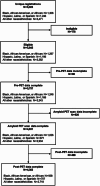Amyloid PET and clinical management in a diverse, cognitively impaired population: The New IDEAS Study
- PMID: 40728069
- PMCID: PMC12305457
- DOI: 10.1002/alz.70504
Amyloid PET and clinical management in a diverse, cognitively impaired population: The New IDEAS Study
Abstract
Introduction: The New Imaging Dementia-Evidence for Amyloid Scanning (IDEAS) study (NCT04426539) evaluated the association between amyloid positron emission tomography (PET) and changes in clinical management among ethnoracially diverse, clinically heterogeneous patients.
Methods: We assessed diagnosis and management plan before and 90 ± 30 days after amyloid PET among Medicare beneficiaries who met 2018 National Institute on Aging-Alzheimer's Association criteria for mild cognitive impairment (MCI) or dementia. We aimed to identify ≥ 30% change in a composite patient management endpoint (CPME; i.e., changes in Alzheimer's disease [AD]/non-AD medications, changes in counseling).
Results: Among 5757 participants (median age 75 years; 21.7% Black, 20.3% Latinx, 58.1% all other races/ethnicities [AORE]), a change in CPME occurred in 59.0% (95% confidence interval 57.6%-60.5%) of individuals post PET. Change varied by ethnoracial identity and type of clinical presentation: Black (MCI: 55.3%, dementia: 55.8%), Latinx (MCI: 53.7%, dementia: 61.9%), AORE (MCI: 62.0%, dementia: 58.3%), typical (MCI: 64.8%, dementia: 60.9%), atypical (MCI 45.5%, dementia: 53.6%).
Discussion: Amyloid PET is associated with clinical management among diverse, clinically heterogeneous populations.
Highlights: Changes in management plan occurred in 59% of patients 90 days after amyloid positron emission tomography. Rates of change in management exceeded the pre-specified goal of > 30% across ethnoracial groups. Rates of change in management also exceeded > 30% among amnestic and non-amnestic Alzheimer's disease presentations.
Keywords: Alzheimer's disease; Medicare; amyloid positron emission tomography; dementia; ethnicity; mild cognitive impairment.
© 2025 The Author(s). Alzheimer's & Dementia published by Wiley Periodicals LLC on behalf of Alzheimer's Association.
Conflict of interest statement
CCW reports receiving grants from the Alzheimer's Association and the NIA. He has received honorariums from LCN, Kinetix Group, and Onviv Inc. CG and BEH report support from the American College of Radiology. JR, LH, and KS were supported by the American College of Radiology through institutional funding. MCC is a full‐time employee of the Alzheimer's Association. EG and AM are salaried employees of the American College of Radiology. IFG and RG report support from the Alzheimer's Association and the American College of Radiology. RAR reports research support from the National Institute on Aging and the Alzheimer's Association and is a consultant for Amydis Inc, Bioivt, Lexeo, Keystone Bio, Allyx, DiamiR, Ionis, and PrecisionMed. BAS reports receiving grants to institution from the American College of Radiology (ACR) during the conduct of the study; personal fees from Avid Radiopharmaceuticals, Curium Pharma, Progenics Pharmaceuticals, Lantheus Medical Imaging, the American Medical Foundation for Peer Review and Education, Siemens Healthineers (for spouse), ACR (also for spouse), Capella Imaging, ECOG‐ACRIN Medical Research Foundation (also for spouse), Evicore Healthcare (for spouse), GE Healthcare, and Radiological Society of North America (also for spouse) outside the submitted work; and grants from Curium Pharma, Progenics Pharmaceuticals, ImaginAb, and Blue Earth Diagnostics outside the submitted work. RAW reports grants from the NIH and NIA and consulting fees from Genentech PanNeuro. She is the epidemiology section editor for
Figures
References
Publication types
MeSH terms
Substances
Grants and funding
LinkOut - more resources
Full Text Sources
Medical
Miscellaneous


